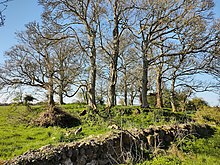
Fairy forts (also known as lios or raths from the Irish, referring to an earthen mound) are the remains of stone circles, ringforts, hillforts, or other circular prehistoric dwellings in Ireland.[1] From possibly the late Iron Age to early Christian times, people built circular structures with earth banks or ditches. These were sometimes topped with wooden palisades and wooden framed buildings. As the dwellings were not durable, only vague circular marks often remained in the landscape.[2] The remains of these structures, in conjunction with the vegetation around them,[3] are associated with local traditions and folklore, perhaps involving fairies or other supposed supernatural entities, who would "defend" the structures from destruction by builders or farmers.[4]
As of 1991, there were between thirty and forty thousand identifiable fairy forts in Ireland's countryside,[5] the oldest of them possibly dating back as early as 600 BCE.[3]
- ^ "Fairy Forts, Music, & Language of Ireland". www.romanceeverafter.com. Archived from the original on 16 June 2007.
- ^ "The Celts & Celtic Ireland". Archived from the original on 7 December 2006.
- ^ a b Barber, Natalie (2014). "The Way They Never Were: Nationalism, Landscape, and Myth in Irish Identity Construction". Georgia State University: 44.
- ^ "Fairy forts: Why these 'sacred places' deserve our respect". irishtimes.com. Irish Times. 9 August 2017. Retrieved 19 May 2020.
- ^ Ó Giolláin, Diarmuid (1991). "The fairy belief and official religion in Ireland". The Good People: New Fairylore Essays. New York: Garland. pp. 199–214. ISBN 9780824071004.
© MMXXIII Rich X Search. We shall prevail. All rights reserved. Rich X Search
